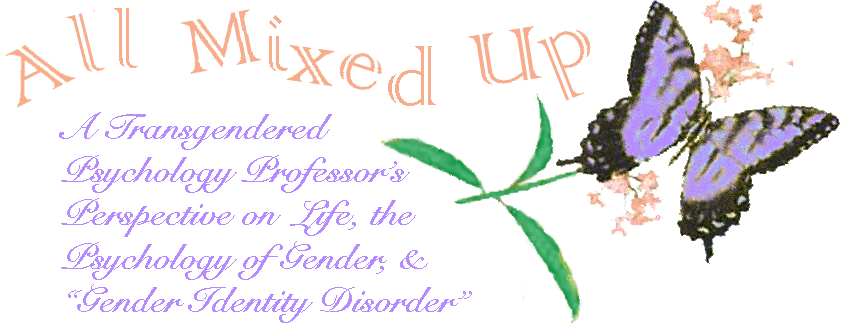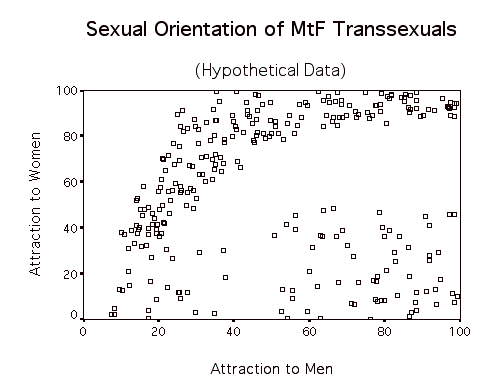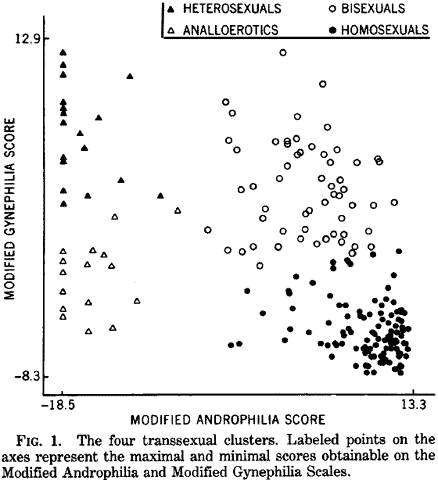
|
|

|
Are transsexuals who are "homosexual" categorically different from those who are "non-homosexual?" Ray Blanchard's own data is inconsistent with this possibility. When analyzing data, Blanchard assumed his categories were true even though statistical methods were readily available; he did not have to beg the question. This is not to say sexual orientation is unimportant. For example, sexual orientation may guide experiences of transsexuals before they "come out."
This is page 7 of 13. [1] [2] [3] [4] [5] [6] [7] [8] [9] [10] [11] [12] [13]
One issue that reoccurs in lots of social science research is how we view people: categorically or variable along a continuum. For example, are there people who are "extraverts" and other people who are "introverts" or is there a continuum from the most gregarious people to exceptionally shy people and all the places in between? Blanchard suggests there are two types of transsexuals: those exclusively attracted to their target sex and those who are not. Another way we could think of transsexuals is varying widely along different attributes. Some transsexuals are very attracted to men, some somewhat so, and some not at all. A second continuum would be the extent to which a transsexual is attracted to women: from not at all to very much so.
The way Blanchard measures sexual orientation in transsexuals is with two continuous scales of sexual orientation. If there really were two groups of transsexuals differentiated by sexual orientation, we would expect that there are two underlying functions of sexual attraction and random variation about those functions. That might sound very confusing. Remember those graphs you made in high-school algebra classes. On one axis goes attraction to women and on the other axis goes attraction to men. Then dots fill the graph paper showing each persons attraction to both men and women. Blanchard (1989) did this and included the scatter-plot in his publication. If his results had supported his hypothesis about two categories of transsexuals, his scatter-plot would look something like the made-up data below. To interpret my made-up scale: 0 means no attraction and 100 is the highest possible level of attraction.

In my made-up data, you can see two clusters of dots that can be interpreted as two types of transsexuals. One type is the cluster of dots in the lower right hand corner ("homosexual transsexuals"). The second type encompases a more diverse arching cluster ("non-homosexual transsexuals"). Does Blanchard's data look like this? Here is his scatter-plot.

Though he has different numbers on the axes, his scatter-plot is oriented the same way mine is (i.e., the lower right-hand corner is the most exclusively "homosexual") Just looking at Blanchard's data, I do not see these two clusters of dots. If anything, I see a cluster of those with attractions to men (i.e., "homosexual" and bisexual as one group and a second group of "hetrosexual" and "non-sexual" transsexuals). Though looking at scatter-plots can sometimes help us see categories, data is rarely so idealized as the made-up data I created. Fortunately there are statistically methods which can see through much more random variation and find out if there really are these two groups hidden in those dots (e.g. latent class analysis). Unfortunately Blanchard did not conduct these tests. He simply assigned participants to one of four groups for analysis: attraction exclusively to men, attraction exclusively to women, attraction to both men and women, attraction to neither men nor women. He used a somewhat fancy statistical way to do this (a cluster analysis with 4 pre-specified ideal values). Explaining this procedure is beyond the scope of the present discussion. What is important to note is that his groupings were something he created, they were not empirically derived. That is, to conclude that there are types of transsexuals is "begging the question": that would assume the very thing he is trying to prove.
Blanchard goes on to conduct analyses using a method specifically for categorical data (ANOVA). It is entirely unclear why he does this because there is a well-established statistical method, that relies on the same statistical assumptions, and which would have let him analyze the data using the original continuous scales (Regression).
As noted earlier, some data shows transsexuals of different sexual orientations differ in several ways. But we need to be cautious about attributing these differences to categorical differences in sexuality. MtF transsexuals attracted exclusively to males may spend more time in the larger GLB community than transsexuals with other sexual orientation. Could this impact the way they see themselves, their types of sexual fantasies, and so on? They might spend more time with other transsexuals in the GLB community. Other transsexuals may start to meet one another in cross-dressing clubs. When transsexuals are meeting in groups, they might start to become more like their in-group (those they spend time with). Well established findings in Social Psychology suggests groups can start to diverge from one another even if there is nothing substantively different between them. How do social psychologists know they are the same? They made up the groups by randomly assigning people to the groups! This process of forming in-groups, out-groups, and forming different attitudes is called, "group polarization."
This is page 7 of 13. [1] [2] [3] [4] [5] [6] [7] [8] [9] [10] [11] [12] [13]
|
|
|